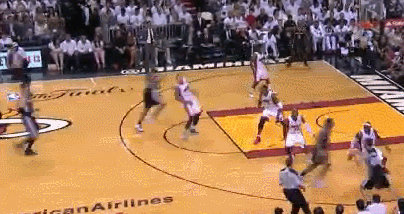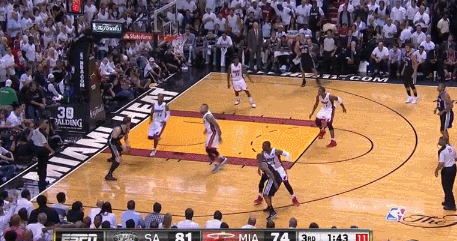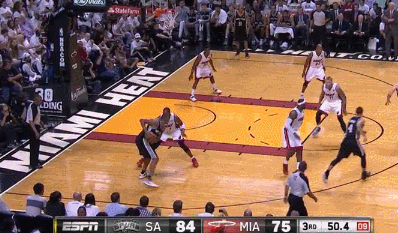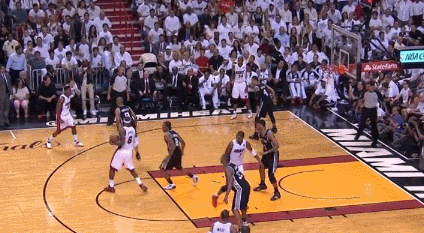Spurs 111, Heat 92: Record first half, Leonard's career night carry Spurs to Game 3 win
What happened?
The San Antonio Spurs jumped on the Miami Heat from the start, built a 25-point first half lead on some of the most efficient scoring ever witnessed, and then held off Miami in the second half thanks to Kawhi Leonard’s career night, taking Game 3 of The Finals, 111-92.
The Scoring
Here’s a Manu Ginobili bucket from late in the first quarter that perfectly exemplifies how beautiful the Spurs’ offense ran in the first half:

With a furious rally in the third quarter that included a 10-0 run, the Heat cut the one time 25-point deficit down to seven, and the crowd inside American Airlines Arena was electric. It could have been a turning point for Miami, but the Spurs responded with a mini 5-1 run over the final 1:37 of the quarter to restore a double-digit lead heading into the fourth. Those five points were courtesy of Marco Belinelli (his only field goal of the game) and Boris Diaw:


Finally, given that Kawhi Leonard scored a career-high 29 points, we should probably include a few of his 10 made field goals on the night:
You can watch all 10 of them here.
Spurs MVP: Kawhi Leonard
Game 3 of the 2014 Finals may be remembered for San Antonio’s blistering, 71-point first half, but in Spurs lore this will forever go down as The Kawhi Leonard Game. Before he missed for the first time of the night at the 3:41 mark of the second quarter, Leonard had scored 16 points on 6-of-6 shooting from the field, 3-of-3 shooting from the perimeter and 3-of-3 shooting from the free throw line.
By the time his night was over, the 22-year-old had set a career-high with 29 points (He hadn’t scored more than 26 points in a game since high school) on 10-of-13 shooting to go with four rebounds, two assists, two steals and two blocks, while playing some of the best defense on LeBron James you’ll see (a big part of James committing seven turnovers):

Here's some extended Leonard D on James:
On a court that featured LeBron James, Tim Duncan, Dwyane Wade, Tony Parker, Chris Bosh, Manu Ginobili and Ray Allen, among others, in an NBA Finals game no less, Leonard was by far the best player on both ends. Reminder: He turns 23-years-old later this month.
Just going to leave this here…
In 3-point era, players who have scored 29+ in a Finals game by age-22: Magic Johnson, Kobe Bryant ... Kawhi Leonard.
— Tom Haberstroh (@tomhaberstroh) June 11, 2014
Heat MVP: LeBron James
James was nowhere near his best tonight, and his seven turnovers were killer, but even a subpar King still gave the Heat 22 points on 9-of-14 shooting, seven assists, five rebounds and five steals in nearly 40 minutes of action. Dwyane Wade was the only other Heat player in consideration here, but he turned it over five times himself and didn’t have the complete game James did.
The Controversy
After a Game 1 that saw a malfunctioning air conditioner and Crampgate, and a Game 2 that saw a questionable elbow and a flopping fine, there aren’t really any controversial plays or storylines coming out of Game 3.
Heat fans may point to the fact that the Spurs attempted 32 free throws to their 24, but the actual fouls were only 26-25, the Spurs were clearly the more aggressive team, and those eight free throws weren't the difference in this one. Not even close.
How did the Spurs win?
The Spurs came out with a different look to start Game 3, starting Boris Diaw in place of Tiago Splitter and abandoning the Splitter/Duncan pairing all together, as the two traditional big men didn’t log a single second together. Playing with a stretch-four for even longer than they have in recent games, when they also utilized the strategy, gave the Spurs some extra spacing. That spacing, combined with almost unfathomable ball movement, allowed the Spurs to score at unprecedented rates in the first half.
The Spurs’ 41-point first quarter was the first 40-point quarter in a Finals game since 2008, the first 40-point first quarter in a Finals game since 1967, and the most efficient first quarter in Tim Duncan’s Spurs postseason tenure. Not to mention, the Spurs’ 75.8 percent shooting in the first half as a whole was a Finals record, and their 21-point halftime lead was the largest halftime lead by a road team in a Finals game since the Bulls took a 24-point lead into the half in Seattle 18 years ago (Game 3, 1996).
Combine that overwhelming first half as a team with Kawhi Leonard’s aforementioned two-way excellence, and the Heat had no chance. Even with Miami’s third quarter rally cutting the lead to seven, the Spurs maintained at least a three-possession cushion from the 7:23 mark of the first quarter onward.
The takeaway
The Spurs almost surely won’t shoot the ball that well again, but Leonard’s awakening should concern the Heat, as San Antonio has yet another weapon at its disposal.
LeBron James usually responds to disappointing performances (by his otherworldly standards) in epic fashion - see Game 2 – and the Heat haven’t lost back-to-back playoff games in a span of 48 games, winning 13 straight postseason contests in which they are coming off a loss. But the Spurs have wrestled home court advantage back in their favor, and they don’t have to worry about beating the Heat twice in a row or even in Miami at all now. If they can win a Game 5 and a Game 7 at home, they’ll be champions.
Stray thoughts
1. Much of the talk following Game 3 will focus on the Spurs’ awesome offensive display, particularly in the first half, and rightfully so. I’m sure there were examples of the Heat failing their defensive assignments throughout the night, but for the most part, despite Mark Jackson’s “hand down, man down” comments, it looked like the Heat were defending fine. The Spurs’ ball movement, overall execution, and above all, their shot making ability in the first half, were just that much better.
Then again, in our Bold Predictions piece, I asked:
The champs have allowed 105.3 points per 100 possessions in the playoffs despite matching up with two bottom-10 offenses (Charlotte, Indiana) and a middle of the pack attack (Brooklyn). What kind of damage might an offense that can actually, y'know, score, inflict?
Perhaps tonight’s Spurs performance answered my question.
2. This game is about the Spurs and Kawhi Leonard, but there was a stretch early in the second half where LeBron James was guarding Tony Parker on one Spurs possession - a strategy that worked wonders for the Heat in Game 2 - and then successfully bodied and defended Tim Duncan in the post on the next. It was yet another reminder that James is a dynamic force the likes of which the NBA has probably never seen before. He also moved into the top-10 in all-time playoff assists on Tuesday. Long live The King.
3. Jeff Van Gundy often complains about the rule that sees the offensive team get five seconds on the shot clock even if they retain possession of a jump-ball after the shot clock had ticked below five, and I have to say he makes a great point. Rule No. 7, Section IV, e. reads as follows:
The 24-second clock shall remain the same as when play was interrupted or reset to 5 seconds, whichever is greater, any time on jump balls retained by the offensive team as the result of a held ball caused by the defense.
If the defense works to force the shot clock below five seconds and gets a jump-ball out of it, why is the offensive team rewarded with extra time just for winning the jump-ball and retaining possession, when no such reward is given if there were more than five seconds remaining on the shot clock? I get the desire for more scoring and making a jump-ball where there would normally be only a half-second on the shot clock, for example, more exciting, but is this rule really necessary?
4. Game 3 captured one of the best, most genuine ‘Wired’ moments of the season, between Gregg Popovich and Tony Parker:
It’s a great moment considering how tough Popovich admittedly was on Parker as a younger player, and great hearing Parker commend his teammate, even when Leonard isn’t present.
(GIF footage courtesy of NBA.com boxscore video)